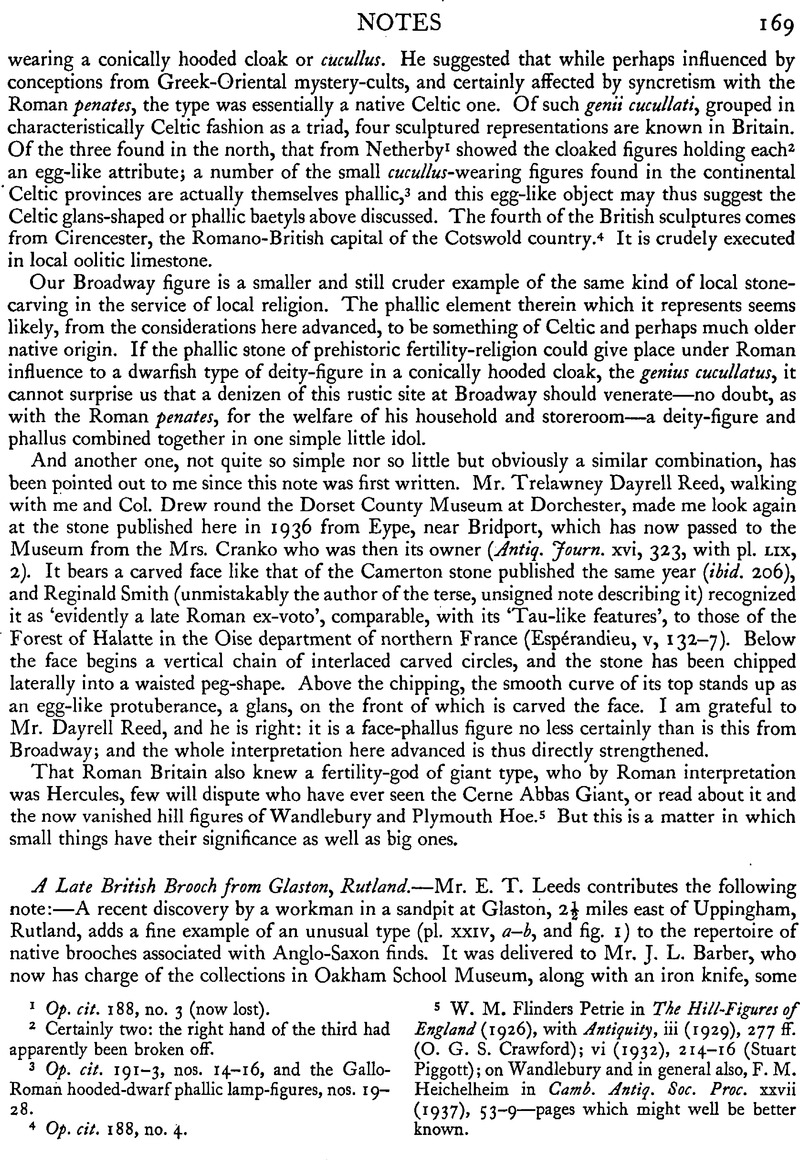No CrossRef data available.
Article contents
A Late British Brooch from Glaston, Rutland
Published online by Cambridge University Press: 08 January 2012
Abstract

- Type
- Notes
- Information
- Copyright
- Copyright © The Society of Antiquaries of London 1948
References
page 170 note 1 The Archaeology of the Cambridge Region, 281, pl. xxxv, 4.
page 170 note 2 Now in the British Museum.
page 170 note 3 This piece is recorded (loc. cit.) as belonging to the collection of Mr. Samuel Gwilt, and on the same plate are figured other objects which are now in the Moyses’ Hall Museum at Bury St. Edmunds, but according to Mr. H. J. M. Maltby, Curator of the Museum, the brooch is not in the museum.
page 171 note 1 Sir Cyril Fox confidently assigns it to the fifth century.
page 171 note 2 Cf. O. Montelius, Civ. prim, en Italic, i, ser. A, pl. XI, 142 and 146.
page 171 note 3 Antiq. Journ. xiii, 240, pl. XXXIII a; Åberg, fig. 12.
page 171 note 4 Oxoniensia, vii, 102, pl. VIII A.
page 171 note 5 Antiq. Journ. xxiii, 107 and 117; pl. xxv a.
page 172 note 1 See A. Plettke, Die Urnenfriedhöfe in Niedersachsen, pl. 1, 2, 7 and 10.
page 172 note 2 Shetelig, op. cit., figs. 20–1.
page 172 note 3 N. Åberg, The Anglo-Saxons in England, group II, 45.
page 172 note 4 Ibid., group III, 81.
page 172 note 5 The Archaeology of Roman Britain, figs. 61–3; see also British Museum, Guide to Roman Britain, 53–4, figs. 60–3.
page 172 note 6 Nordeuropäische Fibelformen der ersten nachchristlichen Jahrhunderte.
page 172 note 7 The Industrial Arts of the Anglo-Saxons, 44, fig. 9.
page 173 note 1 Leeds, Early Anglo-Saxon Art and Archaeology, 129, fig. 3.
page 173 note 2 T. Bateman, Vestiges of the Antiquities of Derbyshire, 93–4; Leeds, loc. cit.
page 173 note 3 F. Moreau, Album Caranda, pl. 103 nouv. sér. and fig. on page facing; Petit Album Caranda, pl. xxxv, 6.
page 173 note 4 The two drawings both appear in Album Caranda and are clearly, from the text, different interpretations of the same brooch.


